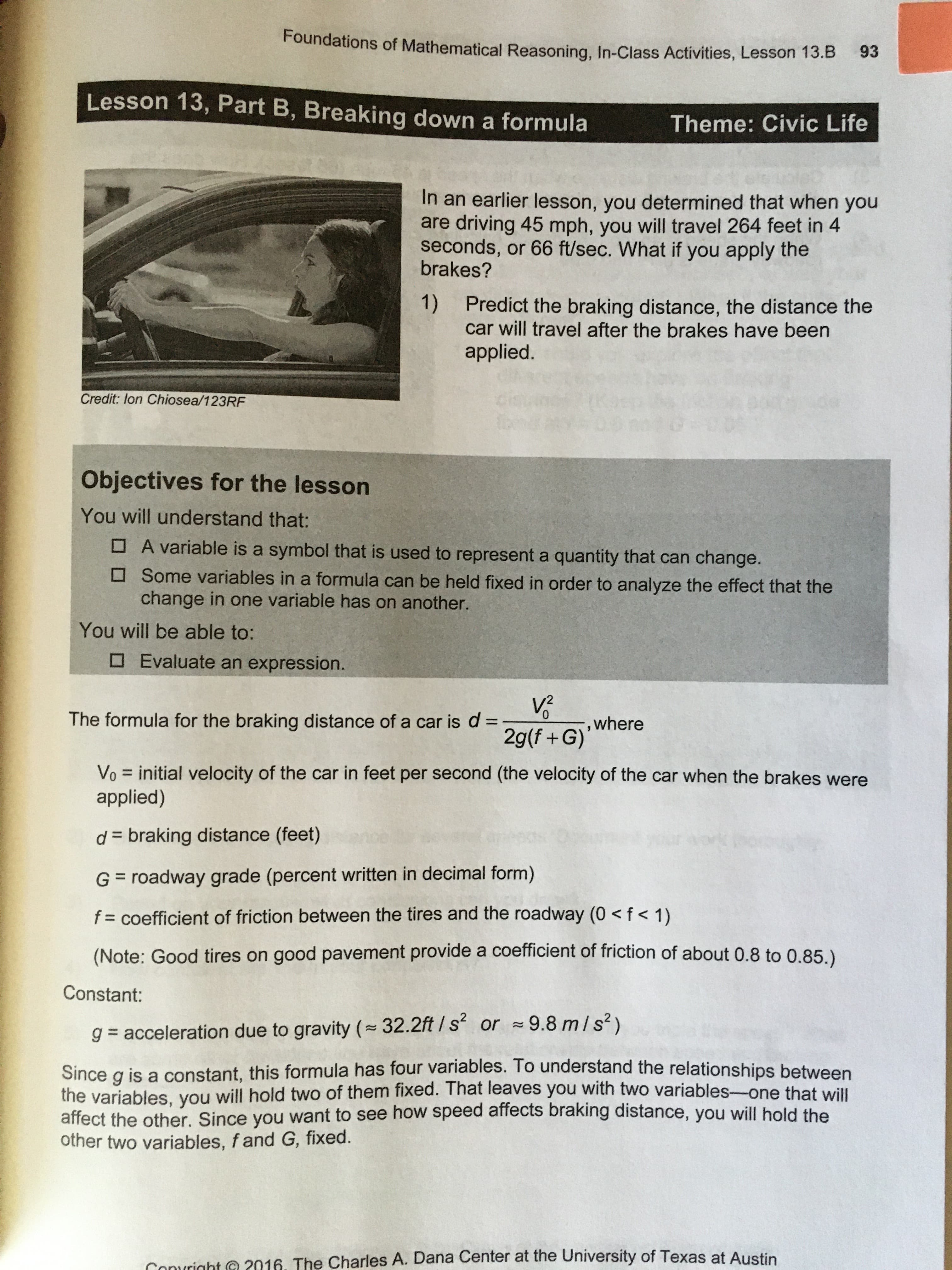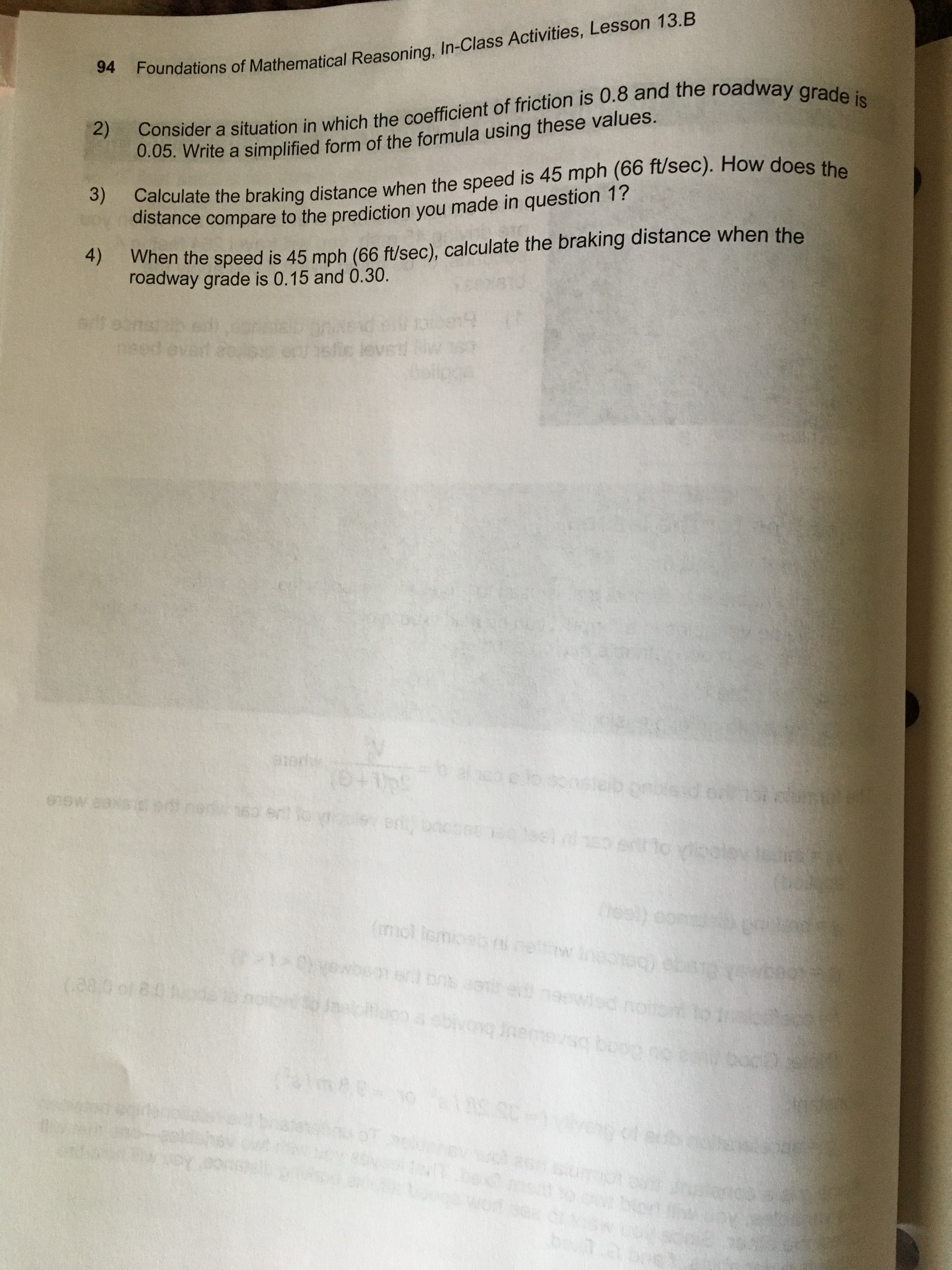Foundations of Mathematical Reasoning, In-Class Activities, Lesson 13.B 93 Lesson 13, Part B, Breaking down a formula Theme: Civic Life In an earlier lesson, you determined that when you are driving 45 mph, you will travel 264 feet in 4 seconds, or 66 ft/sec. What if you apply the brakes? 1) Predict the braking distance, the distance the car will travel after the brakes have been applied. Credit: lon Chiosea/123RF Objectives for the lesson You will understand that: O A variable is a symbol that is used to represent a quantity that can change. O Some variables in a formula can be held fixed in order to analyze the effect that the change in one variable has on another. You will be able to: O Evaluate an expression. The formula for the braking distance of a car is d = 0. ,where %3D 2g(f +G) Vo = initial velocity of the car in feet per second (the velocity of the car when the brakes were applied) %3D d = braking distance (feet) G = roadway grade (percent written in decimal form) f = coefficient of friction between the tires and the roadway (0 < f < 1) (Note: Good tires on good pavement provide a coefficient of friction of about 0.8 to 0.85.) Constant: g = acceleration due to gravity (32.2ft / s or 9.8 m/s²) Since g is a constant, this formula has four variables. To understand the relationships between the variables. you will hold two of them fixed. That leaves you with two variables-one that will affect the other. Since you want to see how speed affects braking distance, you will hold the other two variables, f and G, fixed. Convright C 2016. The Charles A. Dana Center at the University of Texas at Austin Foundations of Mathematical Reasoning, In-Class Activities, Lesson 13.B 94 Consider a situation in which the coefficient of friction is 0.8 and the roadway grade is 2) 0.05. Write a simplified form of the formula using these values. 3) Calculate the braking distance when the speed is 45 mph (66 ft/sec). How does the distance compare to the prediction you made in question 1? 4) When the speed is 45 mph (66 ft/sec), calculate the braking distance when the roadway grade is 0.15 and 0.30. nsed efic leve beliogs 1ert (0+1ps onbieac er bnobeec leel dneo ert to yinolev heol) eon (mol lemi coo 100g0 (beiceU (280 of 8:0oda to noibh ed neewied noito to boog mee10 1AS SC-1vveng of eub e
Foundations of Mathematical Reasoning, In-Class Activities, Lesson 13.B 93 Lesson 13, Part B, Breaking down a formula Theme: Civic Life In an earlier lesson, you determined that when you are driving 45 mph, you will travel 264 feet in 4 seconds, or 66 ft/sec. What if you apply the brakes? 1) Predict the braking distance, the distance the car will travel after the brakes have been applied. Credit: lon Chiosea/123RF Objectives for the lesson You will understand that: O A variable is a symbol that is used to represent a quantity that can change. O Some variables in a formula can be held fixed in order to analyze the effect that the change in one variable has on another. You will be able to: O Evaluate an expression. The formula for the braking distance of a car is d = 0. ,where %3D 2g(f +G) Vo = initial velocity of the car in feet per second (the velocity of the car when the brakes were applied) %3D d = braking distance (feet) G = roadway grade (percent written in decimal form) f = coefficient of friction between the tires and the roadway (0 < f < 1) (Note: Good tires on good pavement provide a coefficient of friction of about 0.8 to 0.85.) Constant: g = acceleration due to gravity (32.2ft / s or 9.8 m/s²) Since g is a constant, this formula has four variables. To understand the relationships between the variables. you will hold two of them fixed. That leaves you with two variables-one that will affect the other. Since you want to see how speed affects braking distance, you will hold the other two variables, f and G, fixed. Convright C 2016. The Charles A. Dana Center at the University of Texas at Austin Foundations of Mathematical Reasoning, In-Class Activities, Lesson 13.B 94 Consider a situation in which the coefficient of friction is 0.8 and the roadway grade is 2) 0.05. Write a simplified form of the formula using these values. 3) Calculate the braking distance when the speed is 45 mph (66 ft/sec). How does the distance compare to the prediction you made in question 1? 4) When the speed is 45 mph (66 ft/sec), calculate the braking distance when the roadway grade is 0.15 and 0.30. nsed efic leve beliogs 1ert (0+1ps onbieac er bnobeec leel dneo ert to yinolev heol) eon (mol lemi coo 100g0 (beiceU (280 of 8:0oda to noibh ed neewied noito to boog mee10 1AS SC-1vveng of eub e
Chapter1: The Study Of Motion
Section: Chapter Questions
Problem 2CA: What is a leap second, and why w it introduced into timekeeping practices by scientists in the 1...
Related questions
Question
100%

Transcribed Image Text:Foundations of Mathematical Reasoning, In-Class Activities, Lesson 13.B
93
Lesson 13, Part B, Breaking down a formula
Theme: Civic Life
In an earlier lesson, you determined that when you
are driving 45 mph, you will travel 264 feet in 4
seconds, or 66 ft/sec. What if you apply the
brakes?
1)
Predict the braking distance, the distance the
car will travel after the brakes have been
applied.
Credit: lon Chiosea/123RF
Objectives for the lesson
You will understand that:
O A variable is a symbol that is used to represent a quantity that can change.
O Some variables in a formula can be held fixed in order to analyze the effect that the
change in one variable has on another.
You will be able to:
O Evaluate an expression.
The formula for the braking distance of a car is d =
0.
,where
%3D
2g(f +G)
Vo = initial velocity of the car in feet per second (the velocity of the car when the brakes were
applied)
%3D
d = braking distance (feet)
G = roadway grade (percent written in decimal form)
f = coefficient of friction between the tires and the roadway (0 < f < 1)
(Note: Good tires on good pavement provide a coefficient of friction of about 0.8 to 0.85.)
Constant:
g = acceleration due to gravity (32.2ft / s or 9.8 m/s²)
Since g is a constant, this formula has four variables. To understand the relationships between
the variables. you will hold two of them fixed. That leaves you with two variables-one that will
affect the other. Since you want to see how speed affects braking distance, you will hold the
other two variables, f and G, fixed.
Convright C 2016. The Charles A. Dana Center at the University of Texas at Austin

Transcribed Image Text:Foundations of Mathematical Reasoning, In-Class Activities, Lesson 13.B
94
Consider a situation in which the coefficient of friction is 0.8 and the roadway grade is
2)
0.05. Write a simplified form of the formula using these values.
3)
Calculate the braking distance when the speed is 45 mph (66 ft/sec). How does the
distance compare to the prediction you made in question 1?
4)
When the speed is 45 mph (66 ft/sec), calculate the braking distance when the
roadway grade is 0.15 and 0.30.
nsed
efic leve
beliogs
1ert
(0+1ps
onbieac
er bnobeec leel dneo ert to yinolev
heol) eon
(mol lemi
coo
100g0 (beiceU
(280 of 8:0oda to noibh
ed neewied noito to
boog
mee10 1AS SC-1vveng of eub e
Expert Solution
This question has been solved!
Explore an expertly crafted, step-by-step solution for a thorough understanding of key concepts.
This is a popular solution!
Trending now
This is a popular solution!
Step by step
Solved in 3 steps with 3 images

Recommended textbooks for you

